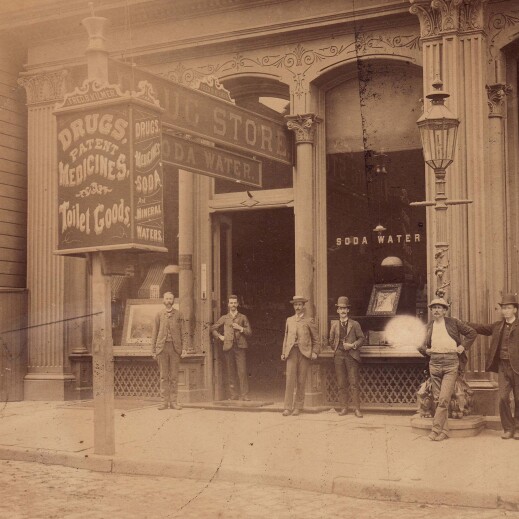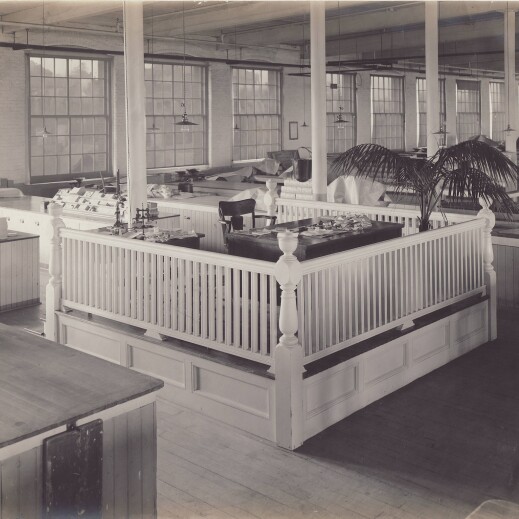- Home
- Our company
- Our history
- From the archives
From the archives
Learn about our iconic, pioneering products and advertisements.

Eucalyptol Linton Moist Gauze
Linton Moist Gauze was one of the earliest Johnson & Johnson sterile surgical dressings. Raw cotton delivered to the company factory was cleaned, processed and woven into sheets. These sheets were then sterilized and infused with eucalyptus, known for its antiseptic and anti-inflammatory properties. First sold in 1887, Linton Moist Gauze was soon packaged in hermetically sealed fruit jars to ensure that they remained germ free. The product continued to be sold in fruit jars up through the 1920s.

James Wood Johnson
Founder James Wood Johnson was a talented engineer whose machines powered the company’s first factories. Johnson also found the first Johnson & Johnson building on a fateful train ride through New Brunswick. In January of 1886, he spotted a “for rent” sign on a nearby factory while riding through the city. That building became Johnson & Johnson’s home later that year.
All-electric powerhouse
The Johnson & Johnson Powerhouse (now the Powerhouse Museum) was constructed in 1907 by the company’s early mill superintendent in charge of manufacturing buildings. Using state-of-the-art technology, the building generated electricity that powered the company’s manufacturing machinery. While many factories at the time still ran on steam, through prudent financial planning and a foresight for technology, Johnson & Johnson was able to upgrade.

A view of the Powerhouse under construction.Johnson & Johnson Archives
Browse the archives

Robert Wood Johnson II
Read more
1943
Robert Wood Johnson II, son of the company founder of the same name, became president of Johnson & Johnson in 1932. During World War II, Johnson was named a one-star brigadier general as head of the Smaller War Plants Corporation in Washington, D.C. The nickname “General Johnson” followed him back to civilian life. He was best known for writing Our Credo in 1943, which outlined the company’s dedication to corporate responsibility, long before that was a common phrase. Our Credo is more than a moral compass: it’s an outline for business success that continues to guide Johnson & Johnson today.
Robert Wood Johnson II, son of the company founder of the same name, became president of Johnson & Johnson in 1932. During World War II, Johnson was named a one-star brigadier general as head of the Smaller War Plants Corporation in Washington, D.C. The nickname “General Johnson” followed him back to civilian life. He was best known for writing Our Credo in 1943, which outlined the company’s dedication to corporate responsibility, long before that was a common phrase. Our Credo is more than a moral compass: it’s an outline for business success that continues to guide Johnson & Johnson today.
Image courtesy: Johnson & Johnson Archives

Scientific Director Frederick B. Kilmer
Read more
1889
Frederick Barnett Kilmer was a respected pharmacist, scientist and public health pioneer before becoming Johnson & Johnson’s scientific director and chief publicity officer in 1889. In his role at the company, he led its publication of groundbreaking medical manuals, including the Hand Book of First Aid in 1901. He quickly expanded the company’s laboratory and invented an industrialized sterilization process. Kilmer enjoyed a long and fruitful career at Johnson & Johnson for the next 45 years.
Frederick Barnett Kilmer was a respected pharmacist, scientist and public health pioneer before becoming Johnson & Johnson’s scientific director and chief publicity officer in 1889. In his role at the company, he led its publication of groundbreaking medical manuals, including the Hand Book of First Aid in 1901. He quickly expanded the company’s laboratory and invented an industrialized sterilization process. Kilmer enjoyed a long and fruitful career at Johnson & Johnson for the next 45 years.
Image courtesy: Johnson & Johnson Archives

Kilmer outside his pharmacy
Read more
1882
Prior to becoming Johnson & Johnson’s scientific director in 1889, Fred Kilmer owned the Opera House Pharmacy in New Brunswick. In this photograph, Kilmer (far left) poses under the shop’s awning. Among the pharmacy’s frequent visitors was famed inventor Thomas Edison, whose workshop was in nearby Menlo Park. Edison often bought materials for his inventions from Kilmer’s business.
Prior to becoming Johnson & Johnson’s scientific director in 1889, Fred Kilmer owned the Opera House Pharmacy in New Brunswick. In this photograph, Kilmer (far left) poses under the shop’s awning. Among the pharmacy’s frequent visitors was famed inventor Thomas Edison, whose workshop was in nearby Menlo Park. Edison often bought materials for his inventions from Kilmer’s business.
Image courtesy: Johnson & Johnson Archives

Women employees’ new uniforms, WWII
Read more
1944
Women employees in the Johnson & Johnson Cotton Finishing Department, New Brunswick, N.J., 1944, show their new uniforms – overalls instead of skirts. During World War II, women employees assumed many traditionally male duties in the workplace when men were serving in the military overseas. Johnson & Johnson had a high percentage of women employees since the company’s founding in 1886.
Women employees in the Johnson & Johnson Cotton Finishing Department, New Brunswick, N.J., 1944, show their new uniforms – overalls instead of skirts. During World War II, women employees assumed many traditionally male duties in the workplace when men were serving in the military overseas. Johnson & Johnson had a high percentage of women employees since the company’s founding in 1886.
Image courtesy: Johnson & Johnson Archives

Men’s employee baseball team, Chicago
Read more
1934
Johnson & Johnson men’s employee baseball team, 1934, Chicago, IL. During the Great Depression, Johnson & Johnson employees maintained their membership in local industrial sports leagues.
Johnson & Johnson men’s employee baseball team, 1934, Chicago, IL. During the Great Depression, Johnson & Johnson employees maintained their membership in local industrial sports leagues.

Training for women supervisors
Read more
1943
Women supervisors being trained at the Johnson & Johnson Gas Mask Plant, Chicago, IL, 1943. With many men overseas in the military during World War II, this Johnson & Johnson facility specifically recruited women employees. Gas masks were one of a number of wartime products Johnson & Johnson produced for the military in the 1940s, including camouflage material, screens to keep disease-carrying insects out of soldiers’ tents, and Duct Tape.
Women supervisors being trained at the Johnson & Johnson Gas Mask Plant, Chicago, IL, 1943. With many men overseas in the military during World War II, this Johnson & Johnson facility specifically recruited women employees. Gas masks were one of a number of wartime products Johnson & Johnson produced for the military in the 1940s, including camouflage material, screens to keep disease-carrying insects out of soldiers’ tents, and Duct Tape.
Image courtesy: Johnson & Johnson Archives

Hiker’s club photograph
Read more
1910-1919
Johnson & Johnson employees in the Hiker’s Club, undated photo 1910-1919. Beginning in the 1890s with an employee baseball team, Johnson & Johnson employees formed a variety of sports teams and clubs to exercise, learn new skills, pursue hobbies and socialize with their colleagues.
Johnson & Johnson employees in the Hiker’s Club, undated photo 1910-1919. Beginning in the 1890s with an employee baseball team, Johnson & Johnson employees formed a variety of sports teams and clubs to exercise, learn new skills, pursue hobbies and socialize with their colleagues.
Image courtesy: Johnson & Johnson Archives

Employee nurses, World War I
Read more
1918
Johnson & Johnson employees who served as nurses stateside during World War I, 1917-1918. Many Johnson & Johnson employees served in the military during World War I, returning to work at the company after the conflict had ended. This group of employees served as nurses in stateside roles during that conflict.
Johnson & Johnson employees who served as nurses stateside during World War I, 1917-1918. Many Johnson & Johnson employees served in the military during World War I, returning to work at the company after the conflict had ended. This group of employees served as nurses in stateside roles during that conflict.
Image courtesy: Johnson & Johnson Archives

Department supervisor’s desk
Read more
1910
Miss Reed’s desk, Cotton Finishing Department, New Brunswick, 1910. This photograph shows the desk of Miss Reed, one of a number of early women department supervisors in the managerial ranks at Johnson & Johnson more than 100 years ago.
Miss Reed’s desk, Cotton Finishing Department, New Brunswick, 1910. This photograph shows the desk of Miss Reed, one of a number of early women department supervisors in the managerial ranks at Johnson & Johnson more than 100 years ago.
Image courtesy: Johnson & Johnson Archives

Women employees’ softball team, Chicago
Read more
1944
Johnson & Johnson Chicago Gas Mask Division Women Employees’ Softball team, Chicago, IL, 1944. During World War II, Johnson & Johnson made a number of products for the war effort including gas masks, camouflage material, screens to protect against disease-carrying insects and Duct Tape.
Johnson & Johnson Chicago Gas Mask Division Women Employees’ Softball team, Chicago, IL, 1944. During World War II, Johnson & Johnson made a number of products for the war effort including gas masks, camouflage material, screens to protect against disease-carrying insects and Duct Tape.
Image courtesy: Johnson & Johnson Archives

World’s Fair certificate
Read more
1893
The 1893 World’s Fair in Chicago saw the debut of both the Ferris Wheel and the zipper. More than 27 million people flocked to the Windy City to enjoy the entertainment and innovations packed into the fairgrounds. Johnson & Johnson was an exhibitor there, and for its display was awarded the fair’s highest honor, the Certificate of Excellence, as well as a special diploma for its innovations in healthcare.
The 1893 World’s Fair in Chicago saw the debut of both the Ferris Wheel and the zipper. More than 27 million people flocked to the Windy City to enjoy the entertainment and innovations packed into the fairgrounds. Johnson & Johnson was an exhibitor there, and for its display was awarded the fair’s highest honor, the Certificate of Excellence, as well as a special diploma for its innovations in healthcare.
Image courtesy: Johnson & Johnson Archives

Employees during the 1890s
Read more
1890s
In this photograph, employees pose with Scientific Director Fred Kilmer. At the turn of the 20th century, as many as 60 percent of Johnson & Johnson’s employees were Hungarian Americans. In fact, many Hungarian immigrants were drawn to New Brunswick at the urging of friends and family who worked at Johnson & Johnson.
In this photograph, employees pose with Scientific Director Fred Kilmer. At the turn of the 20th century, as many as 60 percent of Johnson & Johnson’s employees were Hungarian Americans. In fact, many Hungarian immigrants were drawn to New Brunswick at the urging of friends and family who worked at Johnson & Johnson.
Image courtesy: Johnson & Johnson Archives
Our heritage
Discover Johnson & Johnson’s long legacy of pioneering human health.
Company timeline
Through our timeline, discover the company’s pioneering role in the field of healthcare.
Our stories
Learn how we’re improving the health and lives of people worldwide.